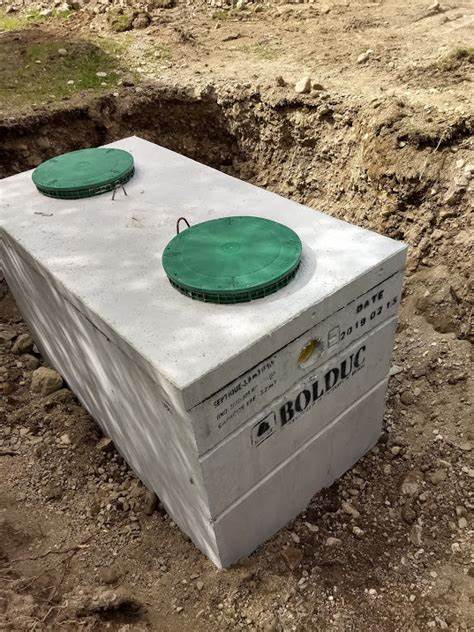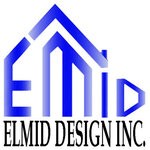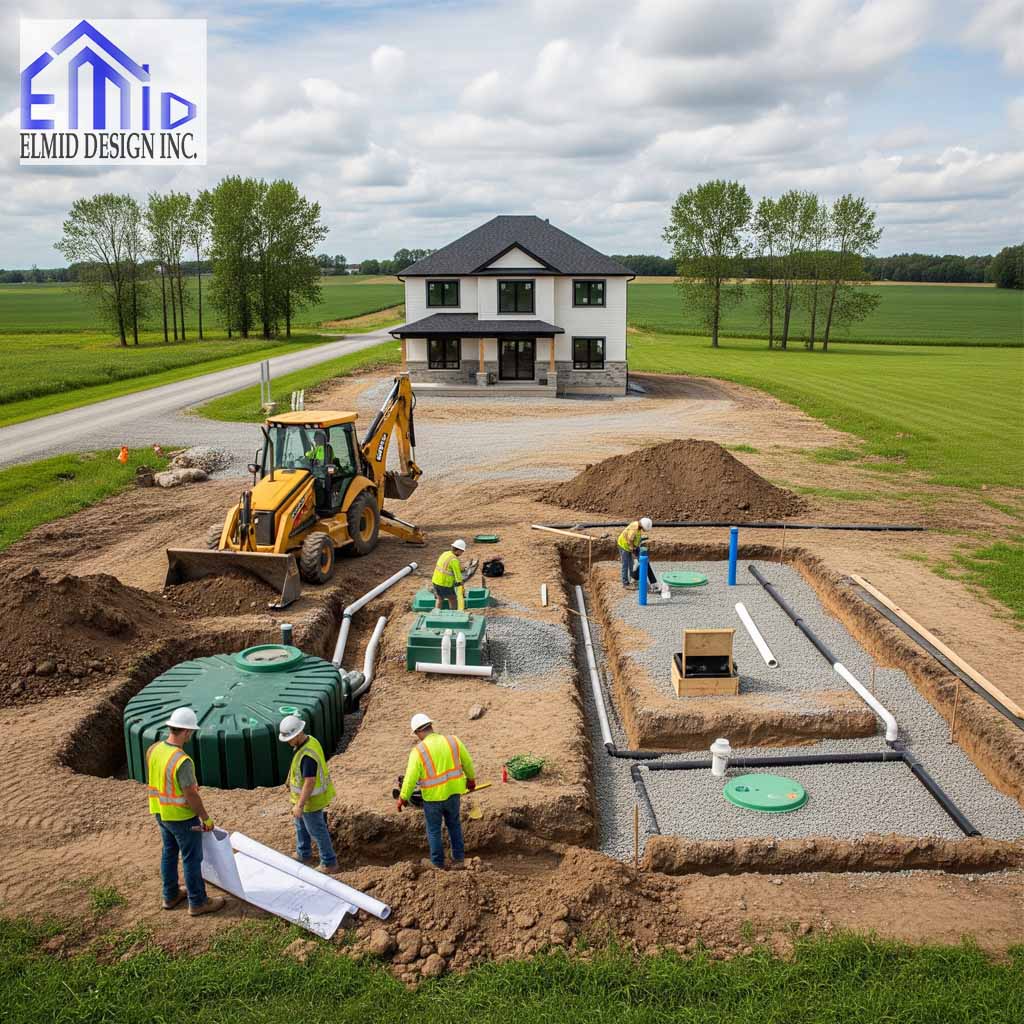A strong septic design is essential in Schomburg where local regulations and soil conditions demand careful planning for reliable wastewater systems.
Overview of Septic Design Requirements in Schomburg
Septic design in Schomburg must comply with the Ontario Building Code and additional municipal guidelines. Under the Building Code Part 8, any system serving a single lot with a daily flow rate under 10 000 L must meet the standardized design parameters, including proper sizing and siting considerations. Local authorities such as King Township may impose further requirements, particularly near water bodies, necessitating inspection and compliance protocols.
Calculating Maximum Daily Flow
Determining Q is a foundational step in septic design. The Ontario Building Code estimates usage based on bedrooms at roughly 500 to 600 L per bedroom. For example, a four‑bedroom home typically generates around 2000 L per day, though additional fixtures or larger living areas can increase that number.
Soil Percolation and Site Evaluation
Site conditions and soil absorption rates, known as “T” time, influence the system layout. Testing involves percolation tests either at a lab or on‑site to determine how rapidly water moves through soil. Sandy soils absorb quickly while clay slows drainage, and poor percolation may require raised systems or tertiary options.
Septic Tank Specifications
Septic tanks must be at least twice the daily flow, with a minimum volume of 3600 L, and feature dual chambers with two‑thirds of the volume allocated to the first chamber. This ensures adequate retention and separation of solids and scum. If a garburator is installed, the required tank size increases to three times .
Separation Distances and Environmental Safety
Regulations in Ontario mandate minimum setbacks for septic systems. Tanks must be installed at least 30 m from drinking water wells and 15 m from surface water. Proximity to lakes, rivers, or streams—especially in regions like Schomburg near the Lake Simcoe watershed—can trigger mandatory inspection programs under the Septic Maintenance Inspection Program for properties within 100 m of water bodies.
Permit Application and Drawings
Permit submissions require detailed site plans that show proposed septic locations, dimensions, and all existing or planned buildings. Soil test data and two test pits are required to validate site suitability. A registered professional must prepare the design and application package.
System Design and Components
Typical systems include a dual‑chamber tank and a gravel leaching bed constructed with perforated pipes and filter fabric, allowing effluent to infiltrate soil. The tank handles primary treatment, while the leaching bed provides biological, chemical, and physical filtration in the soil. Well‑maintained systems depend on keeping solids contained and avoiding clogging.
Maintenance and Operational Best Practices
Ongoing maintenance is essential for long‑term performance. Homeowners must avoid flushing non‑biodegradable items, grease, chemicals, or excess water‑softener discharge into the system. Installation of an effluent filter and regular pump‑outs help prevent clogging of the drain field. Improper use and neglect may damage the system and harm the environment.
Environmental Impacts
A properly designed and maintained septic system protects groundwater and nearby waterways. Failing systems may contribute to nutrient runoff, pathogen contamination, and greenhouse gas emissions such as methane. Prioritizing responsible design and upkeep enhances public health and preserves local ecosystems.
Choosing a Qualified Professional
Selecting a certified septic system designer and installer is critical. In Schomburg and King Township, companies like Smith Excavating, Grading & Septic Services offer full‑service expertise, handling design, installation, inspections, and maintenance in compliance with Ontario standards.

Alternative Treatment Options for Challenging Sites
Homes in Schomburg may sit on poorly draining soils, steep terrain, or compact lots and still need reliable septic solutions. In such cases an advanced treatment system often becomes the smarter choice because it handles wastewater more effectively before the soil absorbs it. Aerobic treatment units inject air to foster bacteria that break down waste efficiently and suit sites with high water tables. Biofilter technologies like peat filters pass septic effluent through media where microbes treat it naturally without electricity. Sand mounds lift and distribute wastewater through fresh sand layers above ground to overcome impermeable soil. Even constructed wetlands mimic nature to filter effluent through plants and gravel. Each of these alternatives serves properties where traditional leaching beds fail because they offer treatment that occurs ahead of soil dispersal and often take up less space or adapt more flexibly.
Cost Considerations of Advanced Systems
Homeowners should expect advanced systems to cost more than conventional ones because they integrate additional treatment steps and mechanical components. In Ontario conventional in‑ground gravity systems for a three‑ or four‑bedroom home typically run from eighteen thousand to thirty‑five thousand dollars, depending on local soil and topography. Advanced treatment systems may range from twenty‑five thousand up to fifty thousand dollars or more, particularly when more rigorous design, maintenance, and permit requirements come into play. Despite higher upfront cost they can become economical compared to conventional systems built on difficult sites because they require a smaller footprint or avoid expensive raised beds. It is essential to weigh lifecycle costs and ongoing maintenance against site suitability and environmental benefits.
Permit, Design, and Site Evaluation Costs
Designing and installing septic systems in Schomburg requires regulatory approvals, particularly under Ontario’s Building Code Part 8. A professional engineer or Registered On‑Site Wastewater Practitioner must conduct soil evaluations, percolation tests, and develop detailed design drawings. Permit fees in Ontario can range from five hundred to two thousand dollars, depending on local delivery agency policies. Soil testing and design services may add several hundred to a few thousand dollars. For example Canadian September Inc. charges around two thousand six hundred dollars for a design package that includes site work, AutoCAD drawings, and health authority filing. Investing in accurate design and permit preparation ensures compliance and smooth approvals.
Comparison of Common Alternative System Types
Chamber septic systems use plastic chambers instead of gravel and offer similar treatment capacity in a compact layout and at modest cost but suit only moderate soil conditions. Sand filters send effluent through sand layers to treat it before dispersal and cost between seven thousand and eighteen thousand dollars. Drip distribution systems use tubes and pumps to dose effluent appropriately on sloped or constrained sites and range from eight thousand to eighteen thousand dollars. Sand mounds elevate the leaching field when soil depth is inadequate and cost ten thousand to twenty thousand dollars. Built wetland systems mimic natural marshes to treat wastewater while offering visual appeal, with installation costs typically between five thousand and twelve thousand dollars. Evapotranspiration beds rely on evaporation and transpiration to dispose of effluent above ground and cost from ten thousand to fifteen thousand dollars.
Environmental and Sustainability Benefits
Choosing an advanced septic solution in Schomburg supports environmental protection and sustainability goals. Treatments like aerobic units, biofilters, or constructed wetlands reduce pathogens and nutrient loads in discharged effluent, helping preserve local groundwater and nearby water bodies, including those feeding Lake Simcoe. Improvements to nutrient removal can also mitigate algal blooms and protect aquatic ecosystems. Treatments that avoid deep soil dispersal and generate cleaner effluent help reduce the system’s ecological footprint. Long‑term benefits include reduced contamination risks and alignment with environmental regulations and climate‑aware community standards.
Maintenance Imperatives for Advanced Systems
Advanced systems deliver higher performance but depend on regular upkeep to maintain function and protect Schomburg’s environment. Aerobic units require attention to aeration components and may need electrical service checks. Biofilters like peat media demand periodic replacement or renewal. Systems with mechanical parts such as pumps or controls need inspections to prevent failures. Wetland and drip systems need monitoring to manage vegetation or flow distribution properly. Budgeting for maintenance safeguards system longevity and avoids costly failures, reinforcing the importance of hiring professionals who know Ontario’s Code requirements and environmental protocols.
Common Inspection Triggers for Schomburg Properties
Properties in Schomberg located within 100 metres of a water body often fall under the Septic Maintenance Inspection Program regulated by the local conservation authority. Inspections occur every five years and must be carried out by a qualified inspector who assesses tank condition, leaching bed function, and separation distances. Evidence of surfacing effluent, tank overflows, or improper clearances can prompt mandatory repairs or full system upgrades. Early inspections help homeowners avoid fines, delays in property transactions, or future liability. Proactive evaluations are recommended even outside the designated inspection zones since the cost of early fixes is far less than that of full system replacement.
The Role of Licensed Designers in Septic Planning
Septic design in Schomberg demands more than simple drawings—it requires knowledge of soil science, hydraulics, building codes, and environmental standards. Licensed professionals such as the engineers at Elmid Design Inc provide accurate soil analysis, calculate daily flow precisely, and develop solutions that meet both Ontario Building Code and local bylaws. These professionals help homeowners navigate the permit process, collaborate with inspectors, and select the right system for the site. A well‑qualified designer also ensures future maintenance is easy and affordable by planning with accessibility and longevity in mind. Engaging a licensed designer strengthens your position during inspections or property sales.
Mistakes to Avoid When Designing Septic Systems
Many septic failures begin with avoidable design errors made during the planning stage. Oversizing or under sizing the tank based on inaccurate daily flow estimates causes system imbalance. Ignoring percolation rates leads to poor absorption and eventual clogging. Poorly planned leaching bed layouts near driveways or trees create access and root infiltration issues. Homeowners who bypass licensed professionals risk setbacks, denied permits, and expensive future modifications. Choosing unapproved materials or installing systems without respecting clearance zones jeopardizes environmental compliance and resale value.
Upgrading or Replacing Aging Systems
Homeowners in Schomberg with septic systems over twenty years old may face replacement to meet current codes or restore functionality. Upgrades may be necessary when new construction or additional bedrooms increase household flow. Signs like odours, wet lawns, or slow drains indicate that replacement could be imminent. Retrofitting older tanks with effluent filters, risers, or baffles helps extend system life while improving performance. In other cases, a full redesign may be the only option, especially if site conditions have changed due to tree growth or construction nearby. Modern replacements deliver better environmental performance and simplify future maintenance obligations.
How Septic Systems Impact Real Estate Transactions
During property sales in Schomberg, the septic system plays a significant role in valuation and approval. Buyers often request septic inspections before closing, and banks may require condition reports to approve financing. Systems that lack permits, documentation, or inspection records can derail deals or lower offers. Real estate agents and legal professionals often recommend providing full service records and the original design file. Homeowners who invested in licensed design from firms like Elmid Design Inc gain a competitive advantage by demonstrating compliance and system reliability. Transparency and proper documentation reduce buyer hesitation and streamline the closing process.
FAQs
How do I choose between a conventional and advanced system in Schomburg
The choice depends on soil percolation, lot size, slope, and proximity to water bodies. Sites with sandy soils and enough space suit conventional systems. Challenging sites with clay or shallow soils need advanced systems like mounds or aerobic units. A licensed designer evaluates your property to make the best recommendation.
What happens if I install a system without a permit in Schomburg
Installing a septic system without a valid permit violates Ontario law and may lead to legal penalties, forced removal, or inability to sell the property. Municipal inspectors can issue orders for corrective work. Permits protect homeowners by ensuring the system meets safety and environmental standards.
How does Elmid Design Inc support septic projects in Schomburg
Elmid Design Inc holds a Certificate of Authorization from Professional Engineers Ontario and offers septic design, site evaluation, and permit application services. They use detailed calculations, AutoCAD plans, and compliance reviews to ensure each project aligns with Ontario Building Code and local requirements.
Can trees affect septic systems
Yes, tree roots may damage leaching pipes or crack tanks. Fast‑growing trees planted too close to septic fields risk root intrusion. It’s essential to plan landscape features with help from your designer who considers long‑term root impact during layout.
Are there grants or rebates for upgrading septic systems in Schomburg
Some conservation authorities and municipal governments offer rebates or incentives for upgrading to environmentally friendly systems near vulnerable water bodies. Eligibility depends on location, income level, and system type. Contact King Township or local conservation offices to check current programs.

Why Elmid Design Inc is Schomburg’s Trusted Septic Design Expert
Elmid Design Inc is a licensed engineering firm proudly holding a Certificate of Authorization from Professional Engineers Ontario. Based in Ontario and serving Schomberg and surrounding areas, the company specializes in septic system design that complies fully with the Ontario Building Code. With deep expertise in site evaluation, soil testing, and advanced treatment planning, Elmid Design Inc ensures every project meets high regulatory and environmental standards. Homeowners, builders, and municipalities rely on their professional precision, fast permit support, and code-compliant designs to build safe and sustainable wastewater solutions.
Geographic Locations That We Service:
Our Licensed Professional Engineers specializing in Engineered Site Grading Plans offer the best-engineered site grading plan, lot grading and erosion plan, and drainage plan to obtain site plan approval and building permits in Ontario, including a wide range of municipalities. Each area boasts unique features and requirements, making our tailored approach essential for success.
Toronto and Surrounding Areas
In the vibrant heart of Ontario, we service Toronto (City of Toronto) and surrounding areas. Additionally, we cover Oshawa (City of Oshawa), Pickering (City of Pickering), and Clarington (Municipality of Clarington). Furthermore, our expertise extends to Ajax (Town of Ajax), Whitby (Town of Whitby), Brock (Township of Brock), Scugog (Township of Scugog), and Uxbridge (Township of Uxbridge).
Halton Region
Moving to the Halton Region, our services encompass Burlington (City of Burlington) and Halton Hills (Town of Halton Hills). Also included are Milton (Town of Milton) and Oakville (Town of Oakville).
Peel Region
In the Peel Region, we provide services in Brampton (City of Brampton), Mississauga (City of Mississauga), and Caledon (Town of Caledon).
York Region
Our services in the York Region cover Vaughan (City of Vaughan), Aurora (Town of Aurora), and East Gwillimbury (Town of East Gwillimbury). We also cater to Georgina (Town of Georgina), Markham (City of Markham), Newmarket (Town of Newmarket), Richmond Hill (City of Richmond Hill), Whitchurch-Stouffville (Town of Whitchurch-Stouffville), King (Township of King), and Bradford-West Gwillimbury (Town of Bradford-West Gwillimbury). Each municipality here offers a distinct setting, requiring our specialized approach.
Other Southern Ontario Cities and Towns
We also serve many other cities and towns in Southern Ontario. These include Hamilton (City of Hamilton), St. Catharines (City of St. Catharines), Niagara on the Lake (Town of Niagara on the Lake), Brant (County of Brant), Cambridge (City of Cambridge), Kitchener (City of Kitchener), Waterloo (City of Waterloo), and Woodstock (City of Woodstock). Furthermore, we operate in Guelph (City of Guelph), Centre Wellington (Township of Centre Wellington), Shelburne (Town of Shelburne), Orangeville (Town of Orangeville), New Tecumseth (Town of New Tecumseth), Essa (Town of Essa), Collingwood (Town of Collingwood), Wasaga Beach (Town of Wasaga Beach), Barrie (City of Barrie), Midland (Town of Midland), Orillia (City of Orillia), Ramara (Town of Ramara), Minden Hills (Town of Minden Hills), North Kawartha (Town of North Kawartha), Kawartha Lakes (City of Kawartha Lakes), Peterborough (City of Peterborough), Selwyn (Town of Selwyn), and Brighton (Municipality of Brighton).




